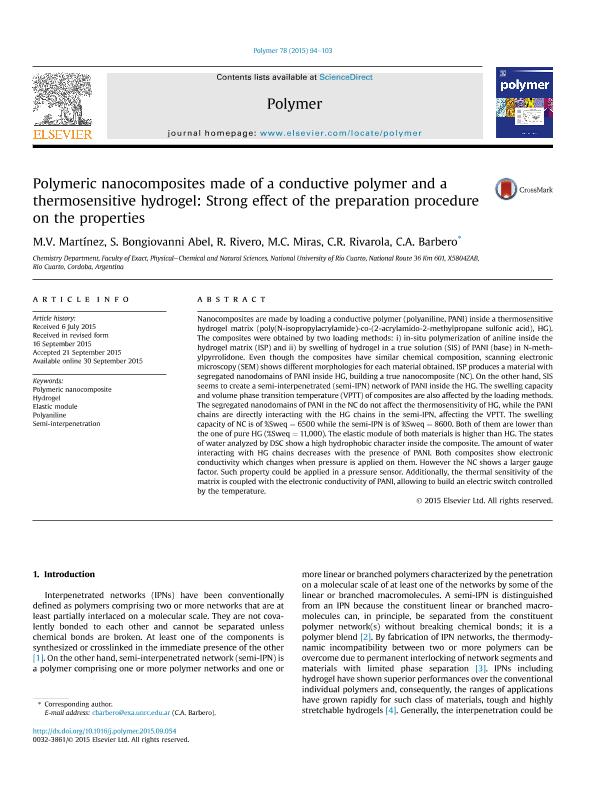Artículo
Polymeric nanocomposites made of a conductive polymer and a thermosensitive hydrogel: Strong effect of the preparation procedure on the properties
Martinez, María Victoria ; Bongiovanni Abel, Silvestre Manuel
; Bongiovanni Abel, Silvestre Manuel ; Rivero, Rebeca Edith
; Rivero, Rebeca Edith ; Miras, Maria Cristina; Rivarola, Claudia Rosana
; Miras, Maria Cristina; Rivarola, Claudia Rosana ; Barbero, César Alfredo
; Barbero, César Alfredo
 ; Bongiovanni Abel, Silvestre Manuel
; Bongiovanni Abel, Silvestre Manuel ; Rivero, Rebeca Edith
; Rivero, Rebeca Edith ; Miras, Maria Cristina; Rivarola, Claudia Rosana
; Miras, Maria Cristina; Rivarola, Claudia Rosana ; Barbero, César Alfredo
; Barbero, César Alfredo
Fecha de publicación:
11/2015
Editorial:
Elsevier
Revista:
Polymer
ISSN:
0032-3861
Idioma:
Inglés
Tipo de recurso:
Artículo publicado
Clasificación temática:
Resumen
Nanocomposites are made by loading a conductive polymer (polyaniline, PANI) inside a thermosensitive hydrogel matrix (poly(N-isopropylacrylamide)-co-(2-acrylamido-2-methylpropane sulfonic acid), HG). The composites were obtained by two loading methods: i) in-situ polymerization of aniline inside the hydrogel matrix (ISP) and ii) by swelling of hydrogel in a true solution (SIS) of PANI (base) in N-methylpyrrolidone. Even though the composites have similar chemical composition, scanning electronic microscopy (SEM) shows different morphologies for each material obtained. ISP produces a material with segregated nanodomains of PANI inside HG, building a true nanocomposite (NC). On the other hand, SIS seems to create a semi-interpenetrated (semi-IPN) network of PANI inside the HG. The swelling capacity and volume phase transition temperature (VPTT) of composites are also affected by the loading methods. The segregated nanodomains of PANI in the NC do not affect the thermosensitivity of HG, while the PANI chains are directly interacting with the HG chains in the semi-IPN, affecting the VPTT. The swelling capacity of NC is of %Sweq = 6500 while the semi-IPN is of %Sweq = 8600. Both of them are lower than the one of pure HG (%Sweq = 11,000). The elastic module of both materials is higher than HG. The states of water analyzed by DSC show a high hydrophobic character inside the composite. The amount of water interacting with HG chains decreases with the presence of PANI. Both composites show electronic conductivity which changes when pressure is applied on them. However the NC shows a larger gauge factor. Such property could be applied in a pressure sensor. Additionally, the thermal sensitivity of the matrix is coupled with the electronic conductivity of PANI, allowing to build an electric switch controlled by the temperature.
Archivos asociados
Licencia
Identificadores
Colecciones
Articulos(CCT - CORDOBA)
Articulos de CTRO.CIENTIFICO TECNOL.CONICET - CORDOBA
Articulos de CTRO.CIENTIFICO TECNOL.CONICET - CORDOBA
Citación
Martinez, María Victoria; Bongiovanni Abel, Silvestre Manuel; Rivero, Rebeca Edith; Miras, Maria Cristina; Rivarola, Claudia Rosana; et al.; Polymeric nanocomposites made of a conductive polymer and a thermosensitive hydrogel: Strong effect of the preparation procedure on the properties; Elsevier; Polymer; 78; 11-2015; 94-103
Compartir
Altmétricas



